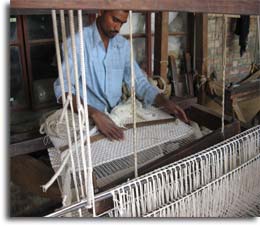Abundance of raw materials and availability of cheap labor are the main reasons for the growth. There is a lot of demand for textiles both from within the country and outside.
Weaving products contribute to 4% of GDP. It is estimated that the industry will grow at a CAGR of 25-30%.
The industry contributes 14% of total industrial output and around 30% of total exports in India. The industry mainly consists of unorganized players. There are approximately 5 million looms in India.

India has the potential to increase its textile and apparel share in the world trade from current level of 4.5% to 8% and reach US $ 80 billion by 2020. Waiver of overdue loans in the handloom sector by Government has benefited 3 lakh handloom weavers. The Government has mooted the idea for integrated textile parks which when implemented will augur well for this industry. Centers of Excellence for research and training will definitely aid the growth of the weaving industry.
 back to weaving INDUSTRies
back to weaving INDUSTRies
 |
INDIAN INDUSTRIES |



 INDIAN WEAVING INDUSTRY AT A GLANCE IN 2011 - 2012
INDIAN WEAVING INDUSTRY AT A GLANCE IN 2011 - 2012